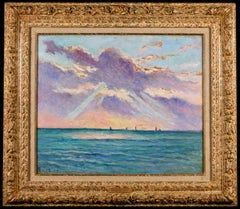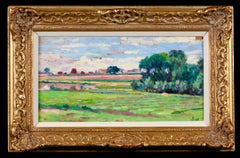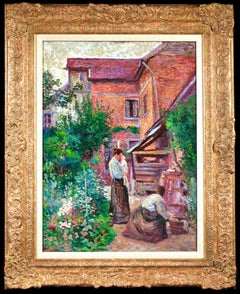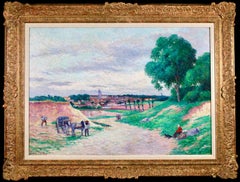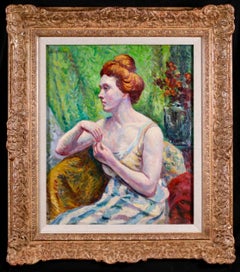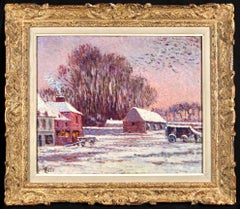Maximillien Luce
1920s Impressionist Landscape Paintings
Canvas, Oil, Laid Paper
1890s Impressionist Landscape Paintings
Oil, Board
1890s Impressionist Figurative Paintings
Oil, Panel
Early 1900s Impressionist Figurative Paintings
Canvas, Oil
Early 1900s Impressionist Portrait Paintings
Canvas, Oil
Recent Sales
Early 1900s Impressionist Figurative Paintings
Oil, Board
Early 20th Century Impressionist Landscape Paintings
Oil, Board
Late 19th Century Impressionist Landscape Paintings
Oil, Panel
Early 20th Century Impressionist Landscape Paintings
Canvas, Oil
1910s Impressionist Still-life Paintings
Canvas, Oil
Early 20th Century Impressionist Landscape Paintings
Oil, Board
People Also Browsed
21st Century and Contemporary Israeli Sterling Silver
Sterling Silver
Antique Early 1900s German Jugendstil Serving Pieces
Silver
1920s Impressionist Figurative Paintings
Canvas, Oil
Early 20th Century French Art Deco Animal Sculptures
Brass
21st Century and Contemporary Italian Modern Chandeliers and Pendants
Murano Glass
Vintage 1960s French Mid-Century Modern Wardrobes and Armoires
Brass
1940s Impressionist Landscape Paintings
Oil, Board
Antique Early 19th Century Russian Russian and Scandinavian Rugs
Wool
21st Century and Contemporary Italian Animal Sculptures
Crystal, Gold Plate, Brass
20th Century Impressionist Figurative Paintings
Oil
1870s Impressionist Landscape Drawings and Watercolors
Paper, Pastel, Board
1890s Expressionist Figurative Paintings
Canvas, Oil
Antique Early 1900s French Art Nouveau Vases
Blown Glass
Antique Early 19th Century Irish Belle Époque Chandeliers and Pendants
Crystal, Bronze
Vintage 1920s French Art Deco Vases
Blown Glass
1880s Impressionist Interior Paintings
Postcard, Oil
Maximilien Luce for sale on 1stDibs
Maximilien Luce was born in Paris in 1858. In 1876 he apprenticed in the shop of the engraver Eugène Froment (1844–1900), a qualified craftsman and graduate of the Ecole des Arts Décoratifs. There, Luce worked on numerous illustrations for French newspapers and foreign periodicals.
In 1877, Luce left Paris and went to London. When he returned to France in 1879 he was called for military service. It was during his military service that Luce met Charles Emile Carolus-Duran (1837–1917), the famous French painter and sculptor who was an instructor to countless artists. Luce entered Carolus-Duran’s studio, a move that not only provided him with meticulous training as a draftsman but also introduced him to the leading painters of the time. Luce met Camille Pissarro (1830–1903), with whom he became very good friends and who gave Luce much artistic advice. Along with Pissarro, Georges Seurat (1859–1891) and Paul Signac (1863–1935), Luce was one of the founders of the Neo-Impressionist School (i.e., the Pointillists).
Luce joined the Société des Indépendants in 1887 and consistently participated in the avant-garde group’s exhibitions. Though landscapes made up most of his oeuvre, Luce executed some marvelous paintings of people in the Pointillist style, and this social realist aspect differentiated him from many of his fellow Neo-Impressionists. For a period of time, Luce was a strict Pointillist. After 1920, however, Luce started to paint in a freer manner. He accepted the position of President of the Société des Artistes Indépendants in 1935, a role from which he would eventually resign as a statement against the society’s growing posture towards restricting Jewish artists from exhibiting.
Luce made a significant contribution to exporting Neo-Impressionism and maintained strong ties with the Belgian Pointillist Théo van Rysselberghe (1862–1926). An indefatigable artist, he left a sizable amount of work in various mediums and remains a very important figure in French Post-Impressionist art. Maximilien Luce died in 1941.
(Biography provided by Stern Pissarro Gallery)A Close Look at Impressionist Art
Emerging in 19th-century France, Impressionist art embraced loose brushwork and plein-air painting to respond to the movement of daily life. Although the pioneers of the Impressionist movement — Claude Monet, Edgar Degas, Paul Cézanne, Berthe Morisot, Camille Pissarro, and Pierre-Auguste Renoir — are now household names, their work was a radical break with an art scene led and shaped by academic traditions for around two centuries. These academies had oversight of a curriculum that emphasized formal drawing, painting and sculpting techniques and historical themes.
The French Impressionists were influenced by a group of artists known as the Barbizon School, who painted what they witnessed in nature. The rejection of pieces by these artists and the later Impressionists from the salons culminated in a watershed 1874 exhibition in Paris that was staged outside of the juried systems. After a work of Monet’s was derided by a critic as an unfinished “impression,” the term was taken as a celebration of their shared interest in capturing fleeting moments as subject matter, whether the shifting weather on rural landscapes or the frenzy of an urban crowd. Rather than the exacting realism of the academic tradition, Impressionist paintings, sculptures, prints and drawings represented how an artist saw a world in motion.
Many Impressionist painters were inspired by the perspectives in imported Japanese prints alongside these shifts in European painting — Édouard Manet drew on ukiyo-e woodblock prints and depicted Japanese design in his Portrait of Émile Zola, for example. American artists such as Mary Cassatt and William Merritt Chase, who studied abroad, were impacted by the work of the French artists, and by the late 19th century American Impressionism had its own distinct aesthetics with painters responding to the rapid modernization of cities through quickly created works that were vivid with color and light.
Find a collection of authentic Impressionist art on 1stDibs.
Finding the Right Landscape-paintings for You
It could be argued that cave walls were the canvases for the world’s first landscape paintings, which depict and elevate natural scenery through art, but there is a richer history to consider.
The Netherlands was home to landscapes as a major theme in painting as early as the 1500s, and ink-on-silk paintings in China featured mountains and large bodies of water as far back as the third century. Greeks created vast wall paintings that depicted landscapes and grandiose garden scenes, while in the late 15th century and early 16th century, landscapes were increasingly the subject of watercolor works by the likes of Leonardo da Vinci and Fra Bartolomeo.
The popularity of religious paintings eventually declined altogether, and by the early 19th century, painters of classical landscapes took to painting out-of-doors (plein-air painting). Paintings of natural scenery were increasingly realistic but romanticized too. Into the 20th century, landscapes remained a major theme for many artists, and while the term “landscape painting” may call to mind images of lush, grassy fields and open seascapes, the genre is characterized by more variety, colors and diverse styles than you may think. Painters working in the photorealist style of landscape painting, for example, seek to create works so lifelike that you may confuse their paint for camera pixels. But if you’re shopping for art to outfit an important room, the work needs to be something with a bit of gravitas (and the right frame is important, too).
Adding a landscape painting to your home can introduce peace and serenity within the confines of your own space. (Some may think of it as an aspirational window of sorts rather than a canvas.) Abstract landscape paintings by the likes of Korean painter Seungyoon Choi or Georgia-based artist Katherine Sandoz, on the other hand, bring pops of color and movement into a room. These landscapes refuse to serve as a background. Elsewhere, Adam Straus’s technology-inspired paintings highlight how our extreme involvement with our devices has removed us from the glory of the world around us. Influenced by modern life and steeped in social commentary, Straus’s landscape paintings make us see our surroundings anew.
Whether you’re seeking works by the world’s most notable names or those authored by underground legends, find a vast collection of landscape paintings on 1stDibs.
